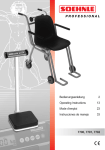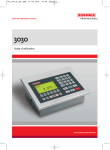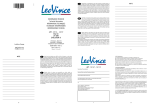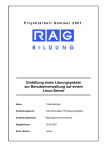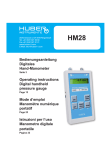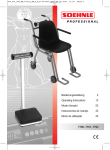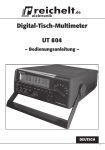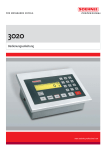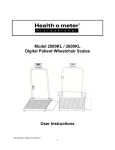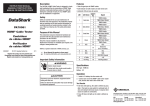Download Soehnle CWC 7746 User's Manual
Transcript
7746_02_99.qxd 10.07.2001 14:56 Uhr Seite 1 CWC 7746 Bedienungsanleitung Getting Started and Operating Instructions Mise en service et mode d’emploi 7746_02_99.qxd 10.07.2001 14:56 Uhr Seite 2 Ihr Soehnle-Servicepartner Your Soehnle-Partner Votre partenaire du service après-vente Soehnle 7746_02_99.qxd 10.07.2001 14:56 Uhr Seite 3 Inbetriebnahme 1 Erläuterung der Typenschilder 1 Technische Information 1 Funktion der Bedientasten 2 Bedienen 2 Anzeigensymbole 3 Wiegen mit Tara 3 Gewichte summieren 4 Entnahme-Wiegen 5 Kommissionieren und Komponenten verwiegen 6 Zählen, Stückzahl summieren 7 Stückzahl-Entnahme 8 Drucken 8 Störungen - Ursachen und Beseitigung 9 Akku-/ Batteriebetrieb 10 Produktunterstützung 10 7746_02_99.qxd 10.07.2001 14:56 Uhr Seite 4 Getting started 11 Specification of the nameplates 11 Technical information 11 Function of the keys 12 Using the scale 12 Display symbols 13 Weighing with tare 13 Totalling weights 14 Weighing using the removal method 15 Components weighing 16 Counting 17 Removal method 18 Printing 18 Malfunctions: Causes and how to eliminate them 19 Accu- / battery operation 20 Product support 20 7746_02_99.qxd 10.07.2001 14:56 Uhr Seite 5 Mise en marche 21 Spécification de la fiche signalétique 21 Informations techniques 21 Fonctions du clavier 22 Manipulation 22 Symboles d’affichage 23 Pesage avec tare 23 Totalisation des poids 24 Pesage des prélèvements 25 Préparation des commandes et Formulation 26 Comptage 27 Prélèvement de marchandises au détail 28 Impression 28 Dérangement, causes et remèdes 29 Fonctionnement sur accu/pile 30 Notice importante pour nos clients français 30 Carnet métrologique 31 Assistance du produit 32 7746_02_99.qxd 10.07.2001 14:56 Uhr Seite 6 Inbetriebnahme Waage am Einsatzort aufstellen. Mit Hilfe von Libelle und Stellfüßen für einen waagrechten Stand sorgen. Kg/lb-Umschaltung Zuerst Taste drücken und halten, dann zusätzlich Taste drücken. Erläuterung des Typenschildes Wägebereich (Wägebereich bei Mehrbereichswaagen) Max Höchstlast des Wägebereichs Min Mindestlast e= SNR Eichwert (Ziffernschritt) Seriennummer (Waagentyp, Endziffer des Fabrikationsjahrs, Zählnummer) 98 EG-Konformitätszeichen mit Jahr der Anbringung, gleichzeitig Beginn der Eichgültigkeit (z.B. CE97) Genauigkeitsklasse, Nr. der EGZulassung (z.B. D97-09-002) Amtl. Nr. (z.B. 0103) der „Benannten Stelle“ (diese Stelle hat die Ersteichung durchgeführt) Zeichen für EG-Eichung Technische Information • Bedienung über Folientastatur mit Druckpunkt. • Netzbetrieb mit Steckernetzteil 230 V/50-60 Hz/ca. 12 VA (Akku-/Batteriebetrieb, siehe Beschreibung auf Seite 10). • Arbeitstemperatur -10 º ..... +40 º C • Lagertemperatur -40 º ..... +70 º C • Nullstellbereich -1% ..... +3 % • Vorlast möglich (Bitte fragen Sie Ihren Händler). • Alle Daten sind spannungsausfallsicher gespeichert. • Serielle Schnittstelle RS 232 (V24). 1 7746_02_99.qxd 10.07.2001 14:56 Uhr Seite 7 Funktion der Bedientasten Die konsequent logische Bedienungsweise eröffnet Ihnen die universelle Leistungsfähigkeit Ihrer Waage. Für die meisten Funktionen genügt ein Tastendruck - wenige Funktionen nutzen Sie mit nur wenigen, immer wiederkehrenden Tastenfolgen. Die Tastatur im Überblick Bedienen Ein - Aus Einschalten (nur bei unbelasteter Waage). Nach Ablauf der Prüfroutine geht Anzeige auf Null. Die Waage ist wiegebereit. Wiegegut auflegen. In der Anzeige erscheint das Bruttogewicht Nullstellen Wenn die Anzeige bei unbelasteter Waage nicht Null anzeigt. Nullstellbereich siehe „Technische Info“. Höhere Auflösung (Taste gedrückt halten) Bruttogewicht Datenübertragung (Drucker / EDV) Kommissionieren Tarieren Summieren In Zählmodus schalten Aufrufen von gespeicherten Werten Befehlskette abbrechen, Speicher löschen Durch Betätigen der entsprechenden Funktionstasten wird Befehl ausgeführt. Ein Signalton bestätigt die Ausführung verschiedener Funktionen. Fehlbedienungen und Fehlermeldungen werden durch 5 aufeinanderfolgende Signaltöne angezeigt. Bitte prüfen Sie die Richtigkeit Ihrer Bedienung - gegebenenfalls unterbrechen Sie die Befehlskette durch Drücken der „CL“-Taste. 2 7746_02_99.qxd 10.07.2001 14:56 Uhr Seite 8 Anzeigensymbole Nullmeldung Stillstandsanzeige Aktiver Bereich (siehe Typenschild) Nettowägung Zählmodus Summenspeicher im Batteriebetrieb - Batterie ersetzen bzw. Akku laden. Komponentenverwiegung Wiegen mit Tara Leeren Behälter tarieren. Waage ist bereit zum Nettowiegen. Anzeigen des Taragewichts Funktionstaste gedrückt halten. Löschen des Taragewichts In der Anzeige erscheint das Bruttogewicht. 3 7746_02_99.qxd 10.07.2001 14:56 Uhr Seite 9 Gewichte summieren Gegebenenfalls Behälter tarieren. Wiegegut auflegen. Gewichtswert in Summenspeicher übernehmen. Wiegegut abnehmen. Gegebenenfalls Tara löschen. Gegebenenfalls neu tarieren. Nächstes Wiegegut auflegen. Gewichtswert in Summenspeicher übernehmen, usw. Anzeigen der Summenspeicher. Netto, Brutto, Tara. Solange Taste + gedrückt, zyklische Anzeige von Netto-, Brutto-, Tarasumme. Löschen der Summenspeicher. Netto, Brutto, Tara. Solange Taste + gedrückt, zyklische Anzeige von Netto-, Brutto-, Tarasumme. Bei Druckeranschluß ist die Funktionstaste „+“und die Tastenkombination „CL/+“ druckauslösend. Der Abdruck erfolgt entsprechend der Druckbilddefinition. Genaue Information, siehe unter „Drucken“. 4 7746_02_99.qxd 10.07.2001 14:56 Uhr Entnahme - Wiegen Seite 10 * siehe auch K-Verwiegung Leeren Behälter auf Waage stellen und tarieren. Wägegut in Behälter füllen. Wenn die Ermittlung des Restgewichts wichtig ist: Gewichtswert in Summenspeicher übernehmen. Funktionstaste „T“ drücken. Bei Entnahme einer Teilmenge wird dies mit Minuszeichen in der Hauptanzeige angezeigt. Ermitteln der Restmenge Wenn Sie das Gesamtgewicht in den Summenspeicher genommen haben, können Sie jetzt die Restmenge ermitteln: Übernehmen Sie zuerst die Entnahmemenge - durch Drücken der Funktionstaste „+“ in den Summenspeicher. Dann die Anzeige des Summenspeichers aufrufen. Nach Drücken der Funktionstaste „T“, geht die Hauptanzeige wieder auf „0“. Sie können jetzt weiter entnehmen. Löschen des Summenspeichers Nach Entlasten der Waage Tarawert löschen. Bei Druckeranschluß ist die Funktionstaste „+“ und die Tastenkombination „Cl/+“ druckauslösend. Der Abdruck erfolgt entsprechend der Druckbilddefinition. Genaue Information siehe unter „Drucken“. Beim Entnahme - Wiegen sind TARA - SUMME und BRUTTO - SUMME nicht korrekt. 5 7746_02_99.qxd 10.07.2001 14:56 Uhr Seite 11 Kommissionieren & Komponenten verwiegen Kommissionieren nur im Wiegemodus Gegebenenfalls Behälter tarieren. Wiegegut auflegen. Gewichtswert in Kommissionsspeicher übernehmen. Der K-Modus wird durch ein Pfeilsymbol angzeigt. Nächstes Wiegegut auflegen. Gewichtswert in Kommissionsspeicher übernehmen,usw. Anzeigen der Summenspeicher. Solange Taste „K“ gedrückt, zyklische Anzeige von K-, Brutto-, Tarasumme. Löschen der Summenspeicher und Verlassen der Kommissionsfunktion. Solange Taste „K“ gedrückt, zyklische Anzeige von K-, Brutto-, Tarasumme. Bei Druckeranschluß ist die Funktionstaste „K“ und die Tastenkombination „Cl/K“ druckauslösend. Der Abdruck erfolgt entsprechnd der Druckbilddefinition. Genaue Information, siehe unter „Drucken“. 6 7746_02_99.qxd 10.07.2001 14:56 Uhr Seite 12 Zählen Waage in Zählmodus schalten Referenzgewicht ermitteln Gegebenenfalls leeren Behälter tarieren. Die von der Waage angeforderte Stückzahl auflegen oder Referenzstückzahl über Taste „+“ weiter schalten bis gewünschte Stückzahl erscheint. (1,2,5,10,20,50) Ausgewählte Stückzahl auflegen und Funktionstaste „Zählen“ drücken. Das durchschnittliche Gewicht eines Teils wird errechnet. Sind die Teile sehr leicht, werden weitere Teile angefordert. Die Anzeige zählt beim Auflegen bis Null zurück. Dann erneut Zähltaste drücken. Zählgut bis zur gewünschten Menge auflegen. Anzeigen des Referenzgewichts Zählvorgang beenden Stückzahl summieren Stückzahl ermitteln. In Summenspeicher übernehmen. Wiegegut abnehmen. Gegebenenfalls Tara löschen. Gegebenenfalls neue Tara ermitteln. Nächste Stückzahl auflegen. In Summenspeicher übernehmen, usw. Anzeigen des Summenspeichers. Löschen des Summenspeichers. Bei Druckeranschluß ist die Funktionstaste „+“ und die Tastenkombination „Cl/+“ druckauslösend. Der Abdruck erfolgt entsprechend der Druckbilddefinition. Genaue Informationen siehe unter „Drucken“. 7 7746_02_99.qxd 10.07.2001 14:56 Uhr Seite 13 Stückzahl - Entnahme Stückzahl (ohne Tara) ermitteln. Zur Ermittlung der Restmenge: Stückzahl in den Summenspeicher übernehmen. Mit Funktionstaste „T“ Anzeige auf Null stellen. Entnahmen werden mit negativem Vorzeichen angezeigt. Zur Ermittlung der Restmenge Funktionstaste „+“ betätigen. Nach weiteren Entnahmen wieder auf Null stellen, usw. Anzeigen des Summenspeichers. Nach Entlasten der Waage muß der Summenspeicher gelöscht werden. Tara löschen. Bei Druckeranschluß ist die Funktionstaste „+“ und die Tastenkombination „Cl/+“ druckauslösend. Der Abdruck erfolgt entsprechend der Druckbilddefinition. Genaue Informationen siehe unter „Drucken“. Drucken Sofern an der Waage ein Drucker angeschlossen ist, wird mit diesen Tasten der Druck ausgelöst. Fragen Sie Ihren Waagenpartner nach geeigneten Druckern oder nach einer EDV-Anbindung. Abdruck Abdruck - addierend in den Summenspeicher Summenabdruck mit Speicherlöschung Abdruck - addierend in den Kommissionsspeicher Summenabdruck mit Speicherlöschung Abdruck mit höherer Auflösung - nur bei nicht eichfähig möglich - . 8 7746_02_99.qxd 10.07.2001 14:56 Uhr Seite 14 Störungen, Ursachen und Beseitigung Anzeige Beseitigung Ein Signalton bestätigt die Ausführung verschiedener Funktionen. Fehlbedienungen werden durch 5 aufeinanderfolgende Signaltöne angezeigt. Bitte prüfen Sie die Richtigkeit Ihrer Bedienung gegebenenfalls unterbrechen Sie die Befehlskette durch Drücken der „Cl“-Taste. Beim Einschalten setzt die Waage automatisch auf Null. Befindet sich die Waage außerhalb des vorgesehenen Toleranzbereichs, zeigt die Anzeige --0--. Die Plattform entlasten. Eventuell Schmutz entfernen. Zeigt die Waage nach einigen Sekunden nicht Null an, bitte Ihren Service -Partner verständigen. Unterlast: Im Anzeigefeld erscheinen nur die unteren Querstriche. Waage ausschalten und wieder einschalten. Der Nullpunkt wird automatisch neu gesetzt. Überlast: Im Anzeigefeld erscheinen nur die oberen Querstriche. Der maximale Wägebereich ist überschritten. Teilegewicht zu klein. Nullstellgrenze über- oder unterschritten Tarierung bei unbelasteter Waage und über max. nicht möglich. Drucken bei Unter- bzw. Überlast nicht möglich. Umschalt kg/lb gesperrt Summenspeicher belegt, muß vor dem Umschalten gelöscht werden. Bei allen anderen Error-Meldungen verständigen Sie bitte Ihren Service-Partner. 9 7746_02_99.qxd 10.07.2001 14:56 Uhr Seite 15 Akku-/Batteriebetrieb Auf der Waagenunterseite befindet sich ein Akkubzw. Batteriefach mit Batteriehalterung. Erforderlich sind 8 Stück Babybatterien oder größengleiche NiCdAkkus. Betriebsdauer je nach Qualität der Batterien oder Akkus ca. 8 Stunden. Im Akku- bzw. Batteriebetrieb wird die Hinterleuchtung automatisch abgeschaltet. Werden wiederaufladbare Batterien über einen längeren Zeitraum nicht benutzt, so müssen Sie alle 4-5 Monate nachgeladen werden. Meldung im Batteriebetrieb Störungs-Beseitigung Restbetriebsdauer ca. 10 min. Im Anzeigenfeld erscheint die Batterie-Leer-Meldung. Batterien wechseln oder Akkus wieder aufladen. Waage läßt sich im Accuoder Batteriebetrieb nicht einschalten. Batterien wechseln oder Akkus wieder aufladen. Wenn Akkus verwendet werden, können diese in der Waage nicht geladen werden. Ein Ladegerät ist im Fachhandel erhältlich. Produktunterstützung Wenn Sie Fragen zu Ihrer Soehnle-Wägeanlage haben, sehen Sie bitte zuerst in der Dokumentation zu diesem Produkt nach. Parameter zur Drucker- und Schnittstellenkonfiguration sind in einem internen Speicher permanent abgelegt. Zugang zur Benutzermodifizierung erhalten Sie über die Tastatur und die LCD-Anzeige. Fordern Sie bei Bedarf die schriftlichen Unterlagen beim SOEHNLE-Partner vor Ort oder direkt beim Hersteller an. Wenn weiterhin Fragen offen sind, sprechen Sie mit dem SOEHNLE-Service-Partner vor Ort oder direkt mit dem Hersteller. Ihr SOEHNLE-Servicepartner SOEHNLE-Waagen GmbH+Co. Abteilung Kundendienst Postfach 1265 D - 71535 Murrhardt Tel. 0 71 92 / 28-1 Fax 0 71 92 / 28-601 eMail: [email protected] 10 7746_02_99.qxd 10.07.2001 14:56 Uhr Seite 16 Getting started Set up the weighing platform at the place required Use the water level and the adjustable feet to ensure that the scale is positioned horizontally. kg/lb-conversation Press key first then press key and hold, additionally. Specification of the nameplate Weighing range (weighing ranges in the case of multi-range scales) Max Range permitted for calibrated Min weighing e= Calibration value (graduation) SNR Serial number (scales type, last digits of year of manufacture, number 98 EU conformity symbol with year applied D93-09-155 precision class, no. of EU admission. Code of the office quoted Sign for EU admission Technical information • Operated by means of a foil keypad. • Mains operation with power supply unit, 230 V/50-60 Hz/ca. 12VA (battery-/accu-operation see instructions). • Operating temperature -10°..........+40°C. • Storage temperature -40°..........+70°C. • Manual resetting range -1%..........+3%. • Initial loading possible (Please contact your dealer). • All data is stored securely against power failure. • Serial RS 232 (V24) interface. 11 7746_02_99.qxd 10.07.2001 14:56 Uhr Seite 17 Function of the keys If you use the display consistently and logically, you will soon discover the universally powerful capacity of the scales. Many functions only require one push of a button - few functions are available with just a few frequently used key sequences. Survey of the keyboard Using the scale On - Off Switch on (only when the scale is not loaded) After the test routine, the main display is set to zero. The scale is ready for use. Place the items on the scale. The gross weight appears in the display. Manual zero resetting When display does not show zero (scale unloaded). Manual zero resetting range see ‘ Technical information’. Higher resolution (hold down the key) Gross weight Data transmission (printer/EDP) Component weighing Tare Add Count Call up saved values Cancel command sequence, delete saved values. The command is executed when the appropriate function key is pressed. An acoustic signal confirms that the entry is correct Incorrect entries are indicated by means of five acoustic signals in swift succession. Please check that your entry is correct. If necessary, cancel the command sequence by pressing the ”CL” key. 12 7746_02_99.qxd 10.07.2001 14:56 Uhr Seite 18 Display symbols Zero message Idle indicator Active range in the case of multi-range scales. Net weighing Counting mode Totals memory Battery operation: Replace battery respectively charge accu. Component weighing Weighing with tare Determine the tare of the empty container Scales are ready to perform net weighing Displaying the tare weight Keep the function key pressed Deleting the tare weight The gross weight appears in the main display 13 7746_02_99.qxd 10.07.2001 14:56 Uhr Seite 19 Totalling weights Determine the tare of the container if necessary. Place the items to be weighed on the scale Transfer the weight value to the totals memory. Take the items to be weighed off the scale Delete the tare if necessary If necessary, enter a new tare. Place the next items to be weighed on the scale. Transfer the weight value to the totals memory, etc. Dispalying the totals memory Net, gross, tare. By holding the key the gross-, tare-, net-total are displayed cyclically in the secondary display. Deleting the totals memory. Net, gross, tare. By holding the key the gross-, tare-, net-total are displayed cyclically in the secondary display. If a printer is connected the ”+” function key and the ”CI/+” key combination activate printing. Printing will take place according to the printing format definition. For more detailed information, see ”Printing”. 14 7746_02_99.qxd 10.07.2001 14:56 Uhr Weighing using the removal method Seite 20 * see component weighing Place the empty container on the scales and determine the tare Fill the container with the items to be weighed If it is important to determine the weight of the remainder: Transfer the weight value to the totals memory Press function key ”T” If part of the original number of pieces is removed, this is displayed with a minus sign in the main display. Determining the remaining number of pieces If you have transferred the overall weight to the totals memory, you can now determine the remaining number of pieces: First transfer the number removed to the totals memory by pressing the ”+” function key. Then call up the totals memory display The main display returns to ”0” after the ”T” function key has been pressed. You can now remove more items. Deleting the totals memory Delete the tare value after removing items from the scales. If a printer is connected the ”+” function key and the ”CI/+” key combination activate printing. Printing will take place according to the printing format definition. For more detailed information, see ”Printing”. When weighing using the removal method the tare sum and the gross sum are not correct. 15 7746_02_99.qxd 10.07.2001 14:56 Uhr Seite 21 Components weighing Commissioning is only possible in weighing mode and on one set of scales Determine the tare weight of the container if necessary. Place the items to be weighed on the scales. Transfer the weight value to the commission memory. The K-mode is indicated by an arrow.. Place the next items to be weighed on the scale. Transfer the weight value to the commission memory, etc. Display the commission memory. By holding the K-key the K-, gross-, tare-total are displayed cyclically.. Delete the commission memory and exit the commissioning function. By holding the K-key the K-, gross-, tare-total are displayed cyclically. If a printer is connected the ”K” function key and the ”CI/K” key combination activate printing. Printing will take place according to the printing format definition. For more detailed information, see ”Printing”. 16 7746_02_99.qxd 10.07.2001 14:56 Uhr Seite 22 Counting Switch the scales to counting mode. Determining the reference weight Tare the empty container if necessary. Place the number of items requested by the scale on the weighing platform or continue selcting the reference number of items by pressing the ”+” key repeatedly until the number of pieces required appears. (1,2,5,10,20,50) Place selected number of items on the weighing platform and press the ”Count” function key-. The average weight of one item is calculated. If the items are very light, more will be requested. The display counts backwards to zero as the items placed on the scales. Now press the Count key again. Place enough items on the scales until the required quantity is reached. Displaying the reference weight Terminating the counting procedure Totalling the number of items to be weighed Determine the number of pieces. Transfer this to the totals memory. Remove the items from the scales. Delete the tare if necessary. Determine a new tare if necessary. Place the next quantity on the scales. Transfer it to the totals memory, etc. Displaying the totals memory Delete the totals memory If a printer is connected the ”+” function key and the ”CI/+” key combination activate printing. Printing will take place according to the printing format definition. For more detailed information, see ”Printing”. 17 7746_02_99.qxd 10.07.2001 14:56 Uhr Seite 23 Removal method Determine the number of pieces (without tare) To determine the remaining number of pieces: transfer the number of pieces to the totals. Set the display to zero by pressing the ”T” function key. The removal of the items is indicated by a minus sign. Press the ”+” function key to determine the remaining number of pieces. When you have removed more items, set the display to zero, etc. Displaying the totals memory The totals memory must be deleted after all items have been removed from the scales. Delete the tare If a printer is connected the ”+” function key and the ”CI/+” key combination activate printing. Printing will take place according to the printing format definition. For more detailed information, see ”Printing”. Printing If a printer is connected those keys activate printing. Please contact your local Soehnle service partner for suitable printers or electronic data processing connection. Key functions Print Print - add to totals memory Print totals and delete memory Print - add to commission memory Print totals and delete memory Print with higher resolution - for scales with internal use -. 18 7746_02_99.qxd 10.07.2001 14:56 Uhr Seite 24 Malfunctions - Causes and how to eliminate them Remedy Indicator An acoustic signal confirms that entry was correct Incorrect entries are indicated by 5 acoustic signals in swift sucession Check that your entry is correct - if necessary interrupt the command sequence by pressing ”C” or ”CI”. The scale sets the value zero automatically when it is switched on. If the scales are outside the set tolerance range, -0- is displayed. Remove the items from the weighing platform. Remove any dirt. If the scales do not indicate zero after a couple of seconds, you should contact your service partner. Underloaded: only the bottom horizontal lines appear on the display Switch the scales off and on again. The zero point will be reset automatically. Overload: Only the top horizontal lines appear on the display. The maximum weighing range has been exceeded. Remove some of the items to be weighing from the scales. Weight of item too light. The zero setting range has been exceeded Taring is not possible in case of over- or underloaded balance Printing is not possible in case of over- or underloaded balance. kg / lb conversion is blocked Totals memory occupied - must be cleared before commutation - In case of all error indications: Please contact your service- partner. 19 7746_02_99.qxd 10.07.2001 14:56 Uhr Seite 25 Accu-/battery operation At the bottom of the scale you can find the battery holder. 8 batteries „baby cells 1,5 C“ or NiCd-accumulators of the same size are required. The length of operation depends on the quality of the batteries or accumulators, e.g. at an accu-capacity of 1,4Ah appr. 8-10 operation hours. During accu-resp. battery operation the background light of the display is switched off automatically. If rechargeable batteries are not used for a longer time, they must be recharged every 4-5 months. Message during battery operation Remedy Residual length of operation app. 10 min. Display shows battery-empty-message. Change batteries or recharge accumulators. Scale cannot be switched on during accu or battery operation. Change batteries or recharge accumulators. If accumulators are used they cannot be recharged in the scale. Battery chargers are available in electronic stores. Product support If you have any questions about your Soehnle weighing system, you should first refer to the documentation for the product. Parameters for printer and interface configuration are permanently stored in an internal memory. Access to user modification is by means of the keypad and LCD display. If required please order the instructions at your local Soehnle service partner or talk to the manufacturer directly. If your questions are still unanswered, contact your local Soehnle service partner or talk to the manufacturer directly. Your Soehnle-Partner Soehnle-Waagen GmbH + Co. Customer Service Department P.O. Box 1265 D-71535 Murrhardt Tel. 0 71 92 / 28-1 Fax 0 71 92 / 28-601 eMail: [email protected] 20 7746_02_99.qxd 10.07.2001 14:56 Uhr Seite 26 Mise en marche Installer la plate-forme de pesage sur le lieu d’utilisation S’assurer qu’elle soit à l’horizontale à l’aide d’un niveau à bulle et des pieds de réglage. Commutation kg/lbs Appuyez d'abord sur la touche , puis simultanément sur la touche . Spécification de la fiche signalétique Plage de pesée (plages de pesée dans le cas de balances multiéchelons) Max Portée maximum Min Portée minimum e= Valeur d`étalonnage (échelon) SNR Numéro de série (type de balance, chiffres finals de l’année de fabrication, numéro de série) 98 Signe de conformité européen CE avec année de son application. Classe de précision, n° de l’homologation européenne D93-09-155: 0103 No de l’organisme vérificateur. Symbole d’homologation européene Informations techniques • Manipulation par l'intermédiaire d'un clavier á effleurement. • Fonctionnement par bloc d'alimentation à connecteur de 230 V/50-60 Hz/env. 12 VA. (fonctionnement sur pile/accu cf. description). • Température de travail - 10º ..... + 40º C. • Température de stockage - 40º ..... + 70º C. • Remise à zéro manuelle - 1% ..... + 3 %. • Prétare possible (Veuillez contacter votre revendeur s.v.p.). • Toutes les données restent mémorisées en cas de panne d'alimentation. • Interface sérielle RS 232 (V 24). 21 7746_02_99.qxd 10.07.2001 14:56 Uhr Seite 27 Fonctions du clavier L’organisation logique du clavier vous facilite la démarche. La plupart des fonctions se déclenche par une seule touche-quelques fonctions seulement demandent une combinaison de touches. Schéma du clavier Manipulation Marche - Arrêt Mise en marche (uniquement dans le cas de balances non chargées). Quand la routine de contrôle est terminée, l’affichage principal passe à zéro. La balance est prête pour la pesée. Mettre en place la marchandise à peser. Le poids brut apparaît sur l’affichage. Remise á zéro manuelle Quand la balance déchargée n'indique pas zéro, appuyer sur cette touche pour la remise manuelle à zéro. La plage de remise à zéro est limitée (cf. informations techniques). Résolution supérieure (maintenir la touche appuyée). Poids brut Transmission de données (imprimante/système informatique). Préparation des commandes. Tarage Totalisation Passage au mode de comptage. Appel de valeurs mémorisées. Interruption de chaînes d’instructions, effacement du contenu de mémoire. L’instruction est exécutée quand on actionne la touche de fonction correspondante. Un signal sonore confirme l’exactitude de l’entrée Les entrées erronées sont signalées par 5 signaux sonores consécutifs. Veuillez vous assurer de l’exactitude de vos entrées - le cas échéant, interrompez la chaîne d’instructions en appuyant sur la touche ”CL” 22 7746_02_99.qxd 10.07.2001 14:56 Uhr Seite 28 Symboles d'affichage Affichage de zéro Affichage de stabilisation du poids. Plage active dans le cas de balances à plusieurs plages Pesée nette Passage au mode de comptage Mémoire totalisatrice En cas de fonctionnement autonomme: Remplacer les piles ou recharger l’accu. Préparation des commandes Pesage avec tare Tarer le récipient vide La balance est prête pour effectuer la pesée nette. Affichage du poids de la tare. Maintenir la touche de fonction appuyée. Effacement du poids de la tare Le poids brut apparaît sur l’affichage principal. 23 7746_02_99.qxd 10.07.2001 14:56 Uhr Seite 29 Totalisation des poids Le cas échéant, tarer le récipient. Mettre en place la marchandise à peser. Enregistrer la valeur du poids dans la mémoire totalisatrice. Retirer la marchandise pesée. Le cas échéant, effacer la tare. Le cas échéant, entrer la nouvelle tare. Mettre en place la marchandise suivante à peser. Enregistrer la valeur du poids dans la mémoire totalisatrice, etc. Affichage du contenu de la mémoire totalisatrice. Effacement du contenu de la mémoire totalisatrice. En cas de raccordement à une imprimante, la touche ”+” et la combinaison de touches ”CL/+” permettent de déclencher l’impression. Cette dernière est effectuée conformément à la défintion de la présentation de l’impression (pour de plus amples informations, se reporter à la section ”Impression”). 24 7746_02_99.qxd 10.07.2001 14:56 Uhr Seite 30 Pesage des prélèvements *cf. pesage de composants Placer le récipient vide sur la balance et procéder au tarage. Verser la marchandise dans le récipient. Si la détermination du poids restant est importante: Enregistrer la valeur du poids dans la mémoire totalisatrice. Appuyer sur la touche de fonction ”T” En cas de prélèvement d’une quantité partielle de marchandise, celle-ci est indiquée par un signe négatif (”-”) sur l’affichage principal. Détermination de la quantité restante Si vous avez enregistré le poids total dans la mémoire totalisatrice, vous pouvez déterminer maintenant la quantité restante: Enregistrez d’abord la quantité prélevée dans la memoire totalisatrice en appuyant sur la touche de fonction ”+”. Appelez ensuite l’affichage du contenu de la mémoire totalisatrice. Quand vous appuyez sur la touche de fonction ”T”, l’ affichage principal retourne sur ”0”. Vous pouvez alors procéder à un autre prélèvement. Effacement du contenu de la mémoire totalisatrice. Effacer la valeur de tare après avoir déchargé la balance. En cas de raccordement à une imprimante, la touche ”+” et la combinaison de touches ”CI/+” permettent de déclencher l’impression. Cette dernière est effectuée conformément à la défintion de la présentation de l’impression (pour de plus amples informations, se reporter à la section ”Impression”). Lors du pesage des prélèvements les sommes des tares et des poids bruts ne sont pas correctes. 25 7746_02_99.qxd 10.07.2001 14:56 Uhr Seite 31 Préparation des commandes et Formulation Préparation des commandes uniquement en mode de pesage et sur une balance Le cas échéant, tarer le récipient. Mettre en place la marchandise à peser. Enregistrer la valeur du poids dans la mémoire de préparation des commandes. Mettre en place la marchandise suivante à peser. Enregistrer la valeur du poids dans la mémoire de préparation des commandes, etc. Affichage du contenu de la mémoire de préparation des commandes. Effacement du contenu de la mémoire de préparation des commandes et abandon de cette fonction. En cas de raccordement à une imprimante, la touche ”K” et la combinaison de touches ”CI/K” permettent de déclencher l’impression. Cette dernière est effectuée conformément à la défintion de la présentation de l’impression (pour de plus amples informations, se reporter à la section ”Impression”). 26 7746_02_99.qxd 10.07.2001 14:56 Uhr Seite 32 Comptage Commuter la balance en mode de comptage. Détermination du poids de référence Le cas échéant, tarer le récipient vide. Mettre en place le nombre de pièces demandé par la balance ou définir la taille de l’échantillon pour la première pesée en appuyant sur la touche ”+” jusqu’à la quantité désirée (1, 2, 5, 10, 20, 50). Une modification permanente de la quantité d’échantillonage est possible comme décrit sous ”Modification par l’utilisateur”. Appuyer sur la touche ”Comptage“. Le poids de référence est calculé. Si toutes les marchandises au détail sont très légères, il faudra ajouter d’autres marchandises. L’affichage retourne au zéro lors de la mise en place des marchandises. Appuyer sur la touche de comptage. Mettre en place la marchandise au détail requise jusqu’à la quantité souhaitée. Affichage du poids de référence Terminer le comptage Totalisation du nombre de marchandises au détail Une mémoire totalisatrice commune est disponible en mode de comptage pour toutes les balances. Détermination du nombre de marchandises au détail. Enregistrer le nombre de marchandises au détail dans la mémoire totalisatrice. Retirer les marchandises pesées. Le cas échéant, effacer la tare. Le cas échéant, entrer la nouvelle tare. Mettre en place les marchandises suivantes à peser. Enregistrer le nombre de marchandises dans la mémoire totalisatrice, etc. Affichage du contenu de la mémoire totalisatrice. Effacement du contenu de la mémoire totalisatrice En cas de raccordement à une imprimante, la touche ”+” et la combinaison de touches ”CI/+” permettent de déclencher l’impression. Cette dernière est effectuée conformément à la défintion de la présentation de l’impression (pour de plus amples informations, se reporter à la section ”Impression”). 27 7746_02_99.qxd 10.07.2001 14:56 Uhr Seite 33 Prélèvement de marchandises au détail Déterminer le nombre de marchandises au détail (sans tare). Pour déterminer la quantité restante: enregistrer le nombre de marchandises au détail dans la mémoire totalisatrice. Régler l’affichage sur zéro à l’aide de la touche de fonction ”T”. Les prélèvements sont indiqués par un signe négatif (”-”) Pour déterminer la qunatité restante: actionner la touche de fonction”+” Après d’autres prélèvements, remettre l’affichage sur zéro, etc. Affichage du contenu de la mémoire totalisatrice. Quand la balance a été déchargée, il faut effacer le contenu de la mémoire totalisatrice. Effacer la tare. En cas de raccordement à une imprimante, la touche ”+” et la combinaison de touches ”CI/+” permettent de déclencher l’impression. Cette dernière est effectuée conformément à la défintion de la présentation de l’impression (pour de plus amples informations, se reporter à la section ”Impression”). Impression Avec une imprimante raccordée, ces touches déclenchement l’impression. Veuillez s.v.p. contacter votre partenaire Soehnle qui peut vous donner plus d’informations sur le raccordement et le choix d’une imprimante. Touches de fonction Impression Impression - additive dans la mémoire totalisatrice. Impression du contenu de la mémoire totalisatrice avec effacement de celui-ci. Impression - additive dans la mémoire de préparation des commandes. Impression du contenu de la mémoire de préparation des commandes avec effacement de celui-ci. Impression à haute précision pour les balances à contrôle interne. 28 7746_02_99.qxd 10.07.2001 14:56 Uhr Seite 34 Dérangement, causes et remèdes Remède Affichage Un signal sonore confirme l’exactitude de l’entrée. Les entrées erronées sont signalées par 5 signaux sonores consécutifs. Veuillez vous assurer de l’exactitude de vos entrées le cas échéant, interrompez la chaîne d’instructions en appuyant sur la touche ”CI” Lors de la mise en marche, la balance passe automatiquement sur zéro. Si la balance se trouve en dehors de la tolérance prévue l’affichage indique ”-0-” Décharger la plate-forme. Retirer éventuellement les salissures. Si après quelques secondes, la balance n’affiche pas zéro, veuillez contacter votre partenaire du service après-vente. Souscharge: Uniquement les tirets inférieurs apparaissant sur l’affichage. Arrêter la balance et la remettre en marche. Le zéro est automatiquement reréglé. Retirer de la balance une Surcharge: Uniquement les partie de la marchandise à tirets supérieurs apparaissent peser. sur l’affichage. La plage de pesage maximum est dépassée. Poids des pièces insuffisant. Balances en dehors de la zone de zéro. Impossible de tarer en cas de surcharge ou de non-charge. Impossible d’imprimer en cas de souscharge ou de surchage. Commutation kg/lb bloquée Mémoire totalisatrice occupée -L’effacer avant de commuter- Autres erreurs: Veuillez contacter votre partenaire du service après-vente. 29 7746_02_99.qxd 10.07.2001 14:56 Uhr Seite 35 Fonctionnement sur accu/pile En dessous de la balance se trouve le boîtier à piles. 8 piles „1,5C“ ou des accumulateurs NiCd de la mème taille sont nécessaires. La durée de fonctionnement dépend de la qualité des piles ou des accumulateurs, avec des accumulateurs de 1,4 Ah la balance marche env. 8-10 heures. Lors d'un fonctionnement sur accu ou sur pile le rétroéclairage s'éteind automatiquement. Les accumulateurs peuvent se décharger sur plusieurs mois quand la balance n'est pas utilisée. Message avec fonctionnement sur pile Remède Réserves de fonctionnement env. 10 min. Affichage indique accu épuisé. Echanger la pile ou charger l'accumulateur. Balance ne se met pas en marche avec une alimentation par accumulateur ou par pile Echanger la pile ou charger l'accumulateur. Si vous utilisez des accumulateurs type RC14 vous devez les sortir de la balance pour la mise en charge et utiliser un chargeur adapté disponible dans le commerce. 30 7746_02_99.qxd 10.07.2001 14:56 Uhr 31 Seite 36 7746_02_99.qxd 10.07.2001 14:56 Uhr Seite 37 Assistance du produit Si nécessaire, demander simplement la documentation auprès de votre partenaire Soehnle, ou directement auprès du fabricant. Votre partenaire du service après-vente Soehnle Allemagne: Soehnle-Waagen GmbH + Co. Export GW Postfach 1265 D-71535 Murrhardt Tél. (+49) 71 92 - 28-1 Fax: (+49) 71 92 - 28-601 eMail: [email protected] Le constructeur vous communiquera l’adresse d’un balancier agrée à votre proximitè. 32 7746_02_99.qxd 10.07.2001 14:56 Uhr Seite 38 Technische Änderungen vorbehalten Subject to technical modifications Sous réserve de modifications techniques 470.051.050 Printed in Germany 02 / 1999
This document in other languages
- français: Soehnle CWC 7746
- Deutsch: Soehnle CWC 7746







































